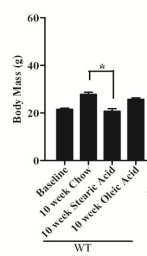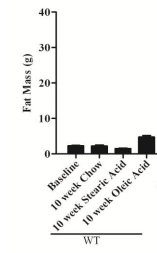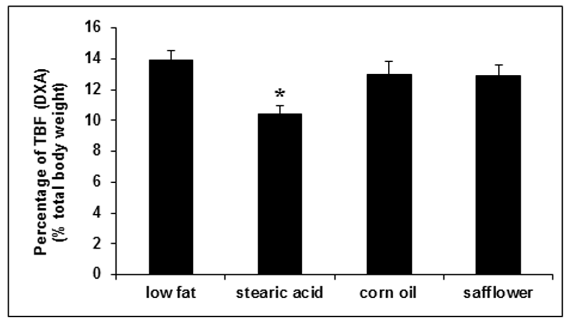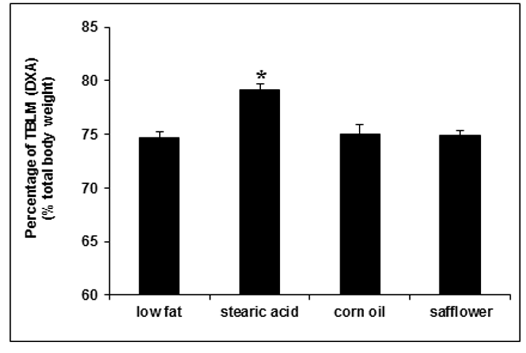If you’ve been reading along you know that by this point we’ve shown that long chain saturated fat consumption causes ROS production in the mitochondria which causes short term physiological insulin resistance. The ROS theory of obesity suggests that physiological insulin resistance should prevent fat storage in peripheral fat cells (adipocytes).
I’ve been dancing around the topic but I’ll put it on the record now. Unsaturated fats (or short chain saturated fats) do not generate as much ROS in the mitochondria and tend to promote insulin sensitivity. Insulin sensitivity should lead to fat gain. Let’s see what happens in wild type (regular) mice.
Valerie Reeves thesis compared wild type mice fed either a typical “chow” diet (17% of calories from fat), a “Stearic Acid” diet (40% of calories from fat, 85% of it as stearic acid, a long chain saturated fat), or an “oleic acid” diet (40% of calories as fat, roughly two thirds as mono-unsaturated fat and one third as polyunsaturated fat). The feeding happened for 10 weeks with the mice having free access to as much food as they wanted. The results are as shown.


Let’s look at the top graph first. The first bar is the weight of the mice before the ten week experimental diet. The second bar shows that the low fat (chow) fed group increased in weight from around 21g to 28g over the ten weeks. The third bar is the mice fed the diet high in long chain saturated fat (stearic acid). That group may have lost a gram of weight over the ten weeks! The final bar is the mice fed 40% of calories as unsaturated fat. They gained about as much as the low fat control diet.
The lower graph shows only the fat mass of the mice. As you can see, the low fat chow diet mice maintained their fat mass over the ten weeks, the long chain saturated fat stearic acid (long chain saturated fat found in beef and chocolate) mice lost close to half of their body fat and the mice fed oleic acid (long chain monounsaturated fat found in olive oil and avocados) had a significant gain in body fat.
A Second Study
In this study , the authors used a strain of nude mice and found the same result. The mice were all given lower fat diets compared to the previous study, around 20% of calories as fat. The diets were described as “a low fat diet (5% corn oil diet) comparable to normal rodent chow, a 20% safflower oil diet, a 17% corn oil/3% safflower oil diet and a 17% stearic acid/3% safflower oil diet.”



The mice fed a diet supplemented with stearic acid, as opposed to a low fat diet or a diet supplemented with corn oil or safflower oil, consumed the most calories, had the lowest body fat and the highest total lean body mass.

Reading the whole blog and it’s quite interesting. Would your implied recommendations be the same for someone who has almost exclusively visceral fat? Eating fairly low carb as is – should one go even lower? Also, I’ve seen a study that shows saturated fat produces more visceral fat than polyunsaturated fat – https://www.ncbi.nlm.nih.gov/pubmed/24550191
That IS an interesting study. I just gave it a 10-minute quick read. The first things that stuck out for me was: the participants were very lean, with a BMI around 20. Clearly this is not a group that struggles with obesity. I wouldn’t expect them to gain much weight and they didn’t. After 7 weeks of force feeding themselves and additional 500-630 calories daily they had gained around three lbs on average, not much. The people eating the PUFA were able to force feed themselves 130 calories more per day than the people eating the SFA. Because ROS is satiation.
The people eating the MOSTLY saturated but still 9% PUFA palm oil, accumulated a statistically significant but hardly biologically significant 0.56% liver fat. That ain’t much!
There’s a lot that goes into this. For instance, polyunsaturated fat’s effect on insulin sensitivity is a U-shaped curve. At around 8% of calories, PUFA causes insulin sensitivity due to lack of superoxide production at the bottleneck. But as PUFA levels rise, you get increased lipid peroxides such as 4-HNE which themselves lead to mitochondrial protein damage and therefore high levels of ROS and then insulin resistance. The sunflower oil used in the study has one of the highest levels of PUFA of any oil. It looks like the participants were getting about 13% of calories as PUFA. That’s a lot!
An interesting topic that this study brings up is the interplay between dietary fat and stored fat and how they are metabolized. The standard story is that the small intestines release fat as chlyomicrons – large blobs that fat cells bite off chunks of by endocytosis. The fats have to be broken into free fatty acids by a lipase, moved into the main fat globule and reesterified into a triglyceride for storage. Then a lipase can come along and convert the triglyceride back into free fatty acids where they can be shuttled to the mitochondria to be oxidized. If this is all true, it argues that the blend of fats stored in your fat cells should trump the effect of dietary fats on your near term metabolism, since it all gets blended prior to metabolism. But that’s not what see in the Spanish study. Interesting area of future research.